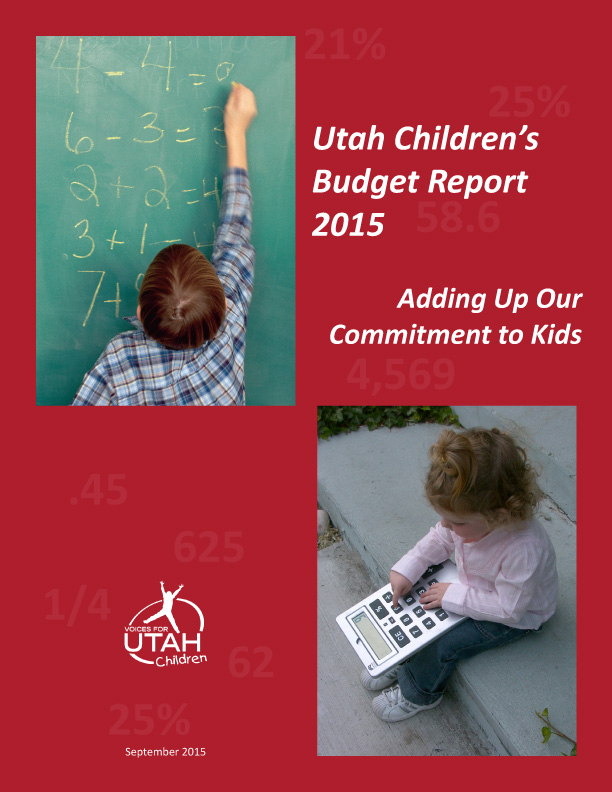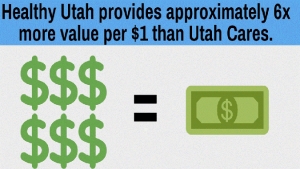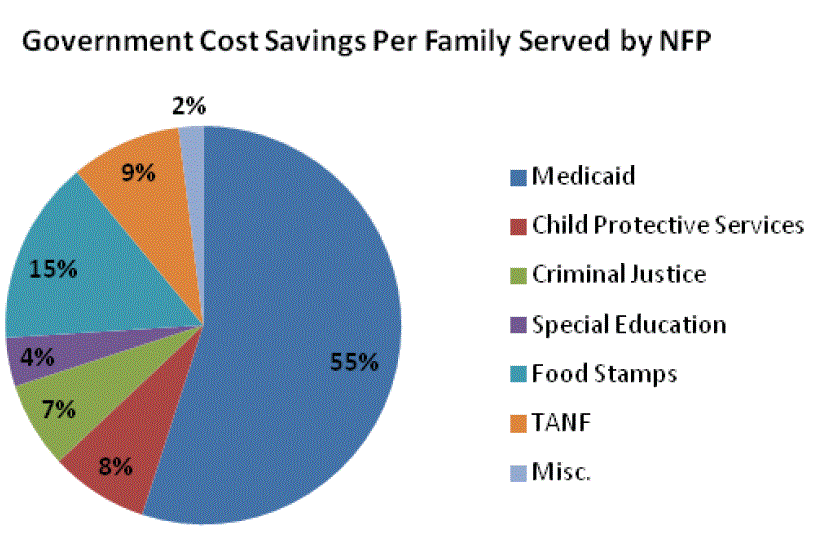State Policy
The Earned Income Tax Credit is a federal tax credit for low- and moderate income families that encourages and rewards work. The credit was created in 1975 under President Ford. Because of its remarkable ability to reduce poverty and promote family health and self-sufficiency, it has been expanded since then by President Reagan and all subsequent presidents.
 For parents, the EITC’s empirically demonstrated effects include:
For parents, the EITC’s empirically demonstrated effects include:State EITCs Offset Regressive Effects of Income, Sales and Property Taxes
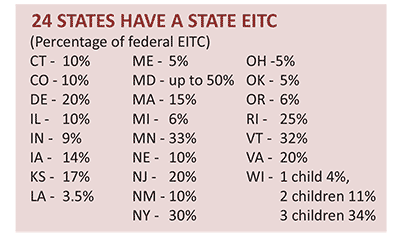 Twenty-four states have created state EITCs to supplement and enhance the impact of the federal program. State EITCs work similarly to and leverage the federal EITC. States rely
Twenty-four states have created state EITCs to supplement and enhance the impact of the federal program. State EITCs work similarly to and leverage the federal EITC. States relyAn Innovative Proposal: Using a State EITC to Promote College Savings and Incent Post-Secondary Education in Utah
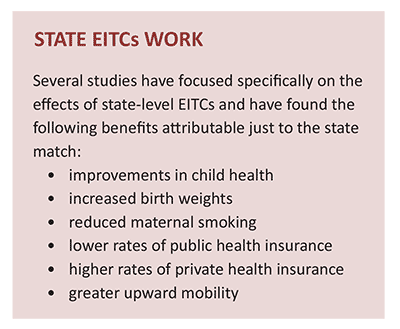 An innovative proposal under discussion for Utah combines two key elements proven to reduce intergenerational poverty:
An innovative proposal under discussion for Utah combines two key elements proven to reduce intergenerational poverty:
The EITC Has Bipartisan Support
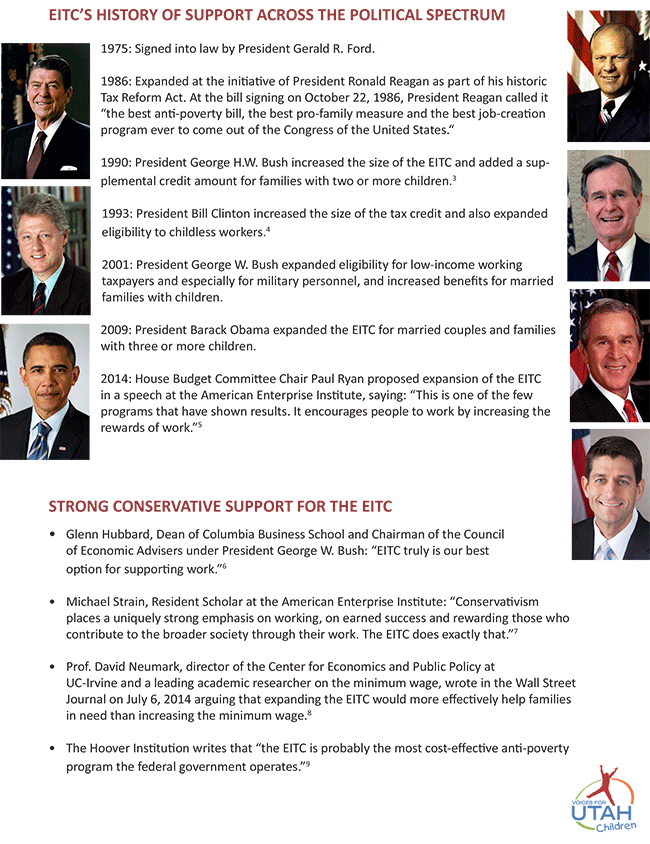
Federal EITC Facts for Utah
Read other issues briefs about two-generation strategies here.
Voices for Utah Children is proud to be a part of the Aspen Institute Ascend Network. The goal of the Aspen Institute Ascend Network is to mobilize empowered two-generation organizations and leaders to influence policy and practice changes that increase economic security, educational success, social capital, and health and well-being for children, parents, and their families. Learn more at http:/ /ascend.aspeninstitute.org/network
For 30 years now, Voices for Utah Children has called on our state, federal and local leaders to put children’s needs first. But the work is not done. The children of 30 years ago now have children of their own. Too many of these children are growing up in poverty, without access to healthcare or quality educational opportunities.
How can you be involved?
Make a tax-deductible donation to Voices for Utah Children—or join our Network with a monthly donation of $20 or more. Network membership includes complimentary admission to Network events with food, socializing, and opportunity to meet child advocacy experts. And don't forget to join our listserv to stay informed!
We look forward to the future of Voices for Utah Children and we hope you will be a part of our next 30 years.
Special thanks to American Express for sponsoring our 30th Anniversary Year. 
The 2015 Children's Budget Report: Adding Up Our Commitment to Kids
Why a “Children’s Budget”?
Children, it is often said, are Utah’s most precious resource. They represent the workforce, consumers, and leaders of tomorrow. For that reason, the investments we make in our children today have enormous economic and social implications for Utah’s future. That is why our federal, state, and local units of government pool taxpayers’ resources to establish an education system, provide for the health and other basic needs of our most vulnerable children, and intervene in children’s lives when their safety is at risk.
This report, Children’s Budget 2015, examines public investment in children from FY2008 through FY2014. It is an update of earlier reports by Voices for Utah Children published in 2009 and 2011. This report does not assess the effectiveness of these programs or gaps in services. Rather, it objectively quantifies the level of public funding for children in Utah and identifies trends over the seven-year period.
There is a strong case to be made that no one cares more about kids than Utahns. Utah has the highest fertility rate in the country and the most children as a percentage of its population, 31% vs. 24% for the nation . Utah saw the second fastest growth rate in its child population of any state from 2000 to 2010 , second only to Nevada (which grows mostly by in-migration rather than through births). Given the high priority Utahns place on children, understanding how much is spent on children by the state and for what purposes is critically important for policymakers and the general public.
Information on funding for children is important for several reasons. It can:
1. Assist policymakers in assessing whether their funding decisions reflect, in the aggregate, their priorities with respect to children.
2. Illustrate how specific programs compare with spending on children overall.
3. Aid policymakers in examining how much is spent on children for specific purposes (i.e. for early education or child welfare) or how funding for children compares to total state and federal spending in the state.
Examining how much Utah invests in children can help the state evaluate how efficiently it is enhancing the potential of our future workforce and maximizing our investment in human capital and economic development. Public investment in children in Utah should be understood as an important component of our economic development strategy that impacts the state as a whole, both in the present and the future.
In this report, Voices for Utah Children divides all state programs concerning children into seven categories, without regard to their location within the structure of state government. The seven categories are as follows, in descending order by dollar value (based on the sums of both state and federal funds):
• Education, which makes up 90% of the state-funded portion of the Children’s Budget and 77% overall counting both state and federal funds
• Health
• Food and Nutrition
• Early Childhood Education
• Child Welfare
• Juvenile Justice
• Income Support
We then add up the expenditures in each of these areas, separating state from federal dollars, and we compare the figures over time from FY2008, the last year before the state budget began to be affected by the Great Recession, through FY2014, the most recent year for which final expenditure data was available.
Our most important finding is the following:
While the state economy has recovered from the Great Recession in a number of respects, state investment in children has not. Specifically, real (inflation-adjusted) state investment in children in FY2014 remained 6% below what it had been in FY2008, at $5,424 per child in FY2014, compared to $5,746 in FY2008.
Making up that $322 per-child gap between the FY2008 level of public investment in children and the level in FY2014 would have required an additional state expenditure in FY2014 of approximately $293 million.
This finding that state government investment in children has not yet recovered from the recession is not the only example of how Utah still remains below its pre-recession performance, even five years after the recession ended. For example, real median wages also remain below pre-recession levels and poverty rates have remained elevated well above where they were at the same point in previous economic expansions.
For more information, see the complete report:
Utah Children's Budget Report 2015
For 30 years now, Voices for Utah Children has called on our state, federal and local leaders to put children’s needs first. But the work is not done. The children of 30 years ago now have children of their own. Too many of these children are growing up in poverty, without access to healthcare or quality educational opportunities. How can you be involved?
- Celebrate the 30th Anniversary of Voices for Utah Children with us at our Children’s Champion Award Luncheon on September 30, 2015.
- Make a tax-deductible donation to Voices for Utah Children—or join our Network with a monthly donation of $20 or more. Network membership includes complimentary admission to the luncheon.
We look forward to the future of Voices for Utah Children and we hope you will be a part of our next 30 years.
Special thanks to American Express for sponsoring our 30th Anniversary Year. 
A Comparison of Utah’s Hispanic and Non-Hispanic White Children and Families
 For 30 years, Voices for Utah Children has been working on issues facing children in the areas of juvenile justice, child welfare, economic stability, education and health. We have become increasingly concerned about racial disparities in all these areas.
For 30 years, Voices for Utah Children has been working on issues facing children in the areas of juvenile justice, child welfare, economic stability, education and health. We have become increasingly concerned about racial disparities in all these areas.
Gathering and analyzing racial and ethnic data is the first step in making informed policy decisions. Those decisions must be guided by comprehensive, regularly updated data. Parsing data through racial and ethnic lenses uncovers patterns and trends that can assist in planning more responsive programs and services.
This Data Link compares Utah’s Hispanic children to white, non-Hispanic children with the goal of helping policymakers develop strategies that eliminate racial disparities and lead to improved child and family outcomes for all Utah’s children.
In 2014 there were 154,419 Hispanic or Latino children under the age of 18 in Utah. They make up 17% of the state’s children. As you can see from the data, these children are more at-risk for poor outcomes than their white non-Hispanic peers.
View the complete report:
For 30 years now, Voices for Utah Children has called on our state, federal and local leaders to put children’s needs first. But the work is not done. The children of 30 years ago now have children of their own. Too many of these children are growing up in poverty, without access to healthcare or quality educational opportunities. How can you be involved?
- Celebrate the 30th Anniversary of Voices for Utah Children with us at our Children’s Champion Award Luncheon on September 30, 2015.
- Make a tax-deductible donation to Voices for Utah Children—or join our Network with a monthly donation of $20 or more. Network membership includes complimentary admission to the luncheon.
We look forward to the future of Voices for Utah Children and we hope you will be a part of our next 30 years.
Special thanks to American Express for sponsoring our 30th Anniversary Year. 
A new report by Notalys, LLC, compares two options for expanding health care coverage to close the insurance gap for an estimated 66,000 Utahns who do not earn enough to receive federal subsidies for insurance but don’t qualify for traditional Medicaid. The Healthy Utah plan significantly expands private insurance for low‐income individuals using federal funds during its pilot period. Until end of 2016, full risk of program falls on the federal government. State portion of costs is 0% initially, rising gradually to 10%. The Utah Cares plan partially expands Medicaid and offers primary care, but not specialty care or hospitalization, to those in poverty using a mix of federal and state funds. Enrollments will be cut in the case of cost‐overruns, and state pays 30% of all costs.
Healthy Utah has six times more value per dollar than Utah Cares—it also costs much less and has lower risk.
Return on Investment:
- Healthy Utah: 24.4
- Utah Cares: 4.1

Take‐Aways:
Only Healthy Utah effectively closes the coverage gap. Thousands under Utah Cares will have access only to primary care, which covers only a small part of health care needs.
- Downside risks under Healthy Utah are borne by the federal government. Under Utah Cares, these risks are shared by the state and may result in significant cutbacks.
- “Woodwork” effects are the most significant long‐term risk faced by both programs, though they are not an unmanageable risk. Because of wider program appeal, woodwork effects are larger under Healthy Utah than Utah Cares.
- Healthy Utah functions predominantly through private insurance, which strengthens lowincome families, reduces financial burdens on health care providers and hospitals, and improves the state’s economy.
Research sponsored by Voices for Utah’s Children, AARP Utah and the Utah Health Policy Project
For more information, see the complete report:
Utah Parents and Families Would Benefit from Medicaid Expansion
 A joint report by the Georgetown Center for Children and Families and Voices for Utah Children finds that:
A joint report by the Georgetown Center for Children and Families and Voices for Utah Children finds that:- In Utah, uninsured parents account for over one third of the population potentially eligible for health coverage if the state expands Medicaid. If Utah does not move forward with Medicaid expansion, or an alternative proposal like Governor Gary Herbert’s Healthy Utah Plan, a significant coverage gap for parents living with dependent children will remain uninsured
- Of low-income, uninsured parents, working parents who are 26 to 49 years old and have school-aged children (6 to17 years old) are most likely to be helped by Medicaid expansion in Utah. Of those parents that could benefit from extended Medicaid eligibility, more than two-thirds (68 percent) are employed.
- Covering parents in Utah offers the state an opportunity to help its children by reducing their uninsured rate, enhancing a family’s financial security, and improving the health of parents. Utah ranks 43rd in the U.S. for percent of uninsured children; consequently there is significant room for improvement.
The complete repert is available here:
Utah Parents and Families Would Benefit from Medicaid Expansion
Learn More and Contact Lawmakers: http://bit.ly/HealthyUtah
A Federal Balanced Budget Amendment Would Result in Funding Cuts for Children's Programs
 HJR7 is a resolution under consideration by the Utah Legislature that would call for a federal Constitutional Convention to consider a balanced budget amendment. It may sound like it's simply sending a message about Utah's support for dealing with the federal debt, but in fact it goes quite a bit further than that. By calling for an unprecedented Article V constitutional convention, HJR7 would make Utah the 26th state of the 34 required to convene a federal constitutional convention, which could end up passing far-reaching changes to the U.S. Constitution on any number of issues. Moreover, a federal balanced budget amendment would likely lead to sudden severe cuts in federal, state, and local budgets, inevitably affecting children first and foremost, particularly lower-income children.
HJR7 is a resolution under consideration by the Utah Legislature that would call for a federal Constitutional Convention to consider a balanced budget amendment. It may sound like it's simply sending a message about Utah's support for dealing with the federal debt, but in fact it goes quite a bit further than that. By calling for an unprecedented Article V constitutional convention, HJR7 would make Utah the 26th state of the 34 required to convene a federal constitutional convention, which could end up passing far-reaching changes to the U.S. Constitution on any number of issues. Moreover, a federal balanced budget amendment would likely lead to sudden severe cuts in federal, state, and local budgets, inevitably affecting children first and foremost, particularly lower-income children.
More Information
What’s Wrong with Calling for a Constitutional Convention to Enact a Balanced Budget Amendment?
Contact Lawmakers
Uninsured Rates High for Hispanic Children
Utah has Highest Uninsured Rate for Hispanic Children in the Nation
Every child in Utah should have a chance to succeed. When it comes to setting up a child for success, few things matter more than good health. It starts when their mothers get prenatal care. It continues with regular checkups after they are born to treat and, more importantly, prevent illness. Good health care helps children reach important developmental milestones and enter school ready to learn. Coverage is essential to children reaching their full potential. Unfortunately, too many Utah children are uninsured. This is particularly true for Hispanic children in our state.
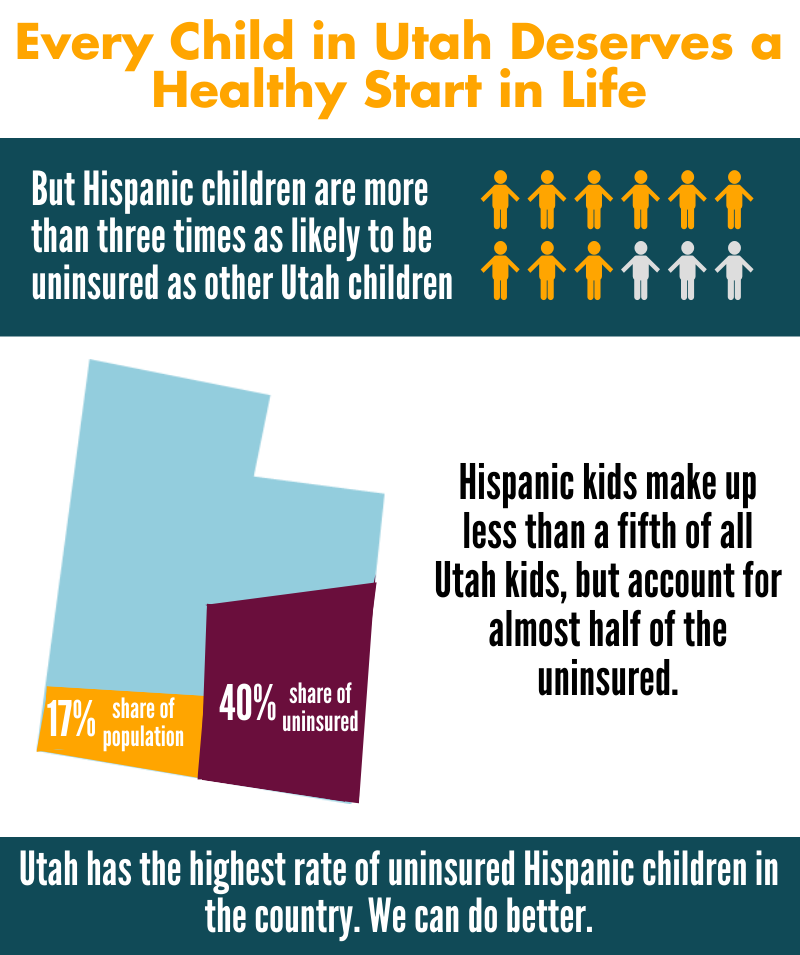 • 22.2% of Hispanic children are uninsured in Utah. This is the highest rate in the nation by far and is twice as high as the national average for Hispanic kids of 11.5%.
• 22.2% of Hispanic children are uninsured in Utah. This is the highest rate in the nation by far and is twice as high as the national average for Hispanic kids of 11.5%.
• 22.2% of Hispanic kids are uninsured compared to only 7% of non-Hispanic children. This 11 percentage point disparity is the largest disparity in the country. Nationally, the average disparity is only 5 percentage points.
• Hispanic children make up 16.9% of Utah’s total child population but account for 39% of the uninsured children in the state. Of the 84,891 uninsured kids in Utah, 33,531 of them are Hispanic.
• Utah’s overall uninsured rate for kids is 9.5%, ranking us 41st (highest being worst) in the country. The national average is 7.1%. If we reduced our Hispanic uninsured rate to the national average of 11.5%, Utah’s overall uninsured rate for kids would drop to 7.5% and Utah would have the 19th best uninsured rate in the country for kids.
If we want more children to succeed in life, we must secure coverage for more of our children, regardless of ethnicity or race. We can begin to remove hurdles facing uninsured Hispanic children and set all of Utah’s children on a path to success by implementing a few first steps:
• Restore outreach funding for Medicaid and CHIP;
• Make it easier for children to keep their health coverage by implementing 12 month continuous eligibility;
• Remove the Medicaid and CHIP five year waiting period that legal immigrant kids must endure before enrolling in these programs.
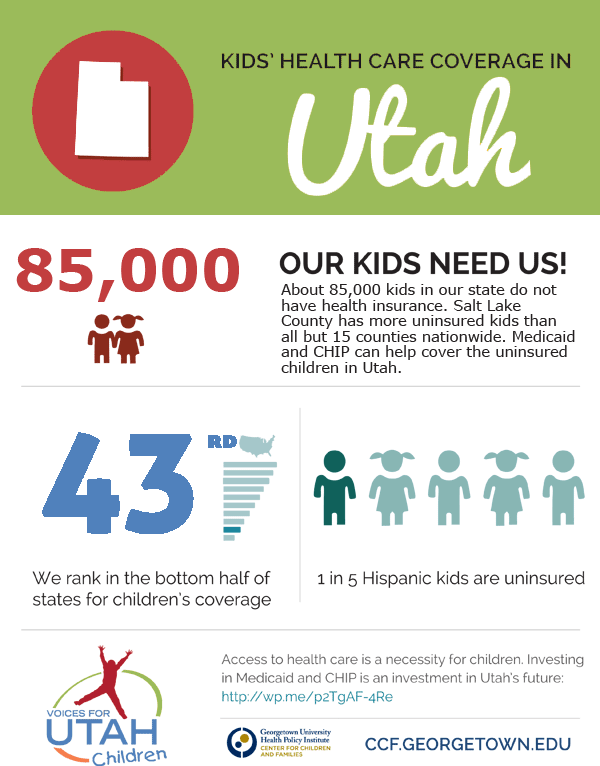
Printer-friendly version of this factsheet:
Nurse Family Partnership
Nurse Family Partnership (NFP) is a voluntary evidenced-based community health program that provides ongoing home visits (from pregnancy through age 2 of the child) from a registered nurse to low-income, first time mothers to provide the care and support they need to have a healthy pregnancy, be a responsible and caring parent, and to become more economically self-sufficient. A nurse visits the women approximately weekly and bi-monthly during their pregnancy and after birth, and then monthly visits during the first two years of their children’s lives. The program is a two-generation intervention and improves outcomes for both the mother and the child. NFP produces very strong outcomes for very high risk, low-income populations.
Economic analyses performed by the Washington State Institute for Public Policy, the Brookings Institute and the Rand Corporation determined that NFP provides a return on investment for taxpayers of $2.37 to $5.70 (high-risk population) per $1 invested in the program.
Download the printer-friendly report:
Nurse Family Partnership
Proven Outcomes
National outcomes associated with NFP, verified through independently evaluated randomized controlled trials, include long term family improvements in health, child welfare, education and self-sufficiency. When brought to scale, NFP can achieve:
• 23% reduction in smoking during pregnancy
• 26% reduction in pregnancy-induced hypertension
• 18% reduction in first pre-term births
• 58% reduction in infant deaths
• 30% reduction in second teen births
• 37% reduction in childhood injuries treated in emergency departments up to age 2
• 30% reduction in child maltreatment
• 38% reduction in language delay of the child by age 2
• 45% reduction in crimes and arrests, ages 11-17
• 51% reduction in alcohol, tobacco and marijuana use, ages 12-15
• 15% reduction in TANF and Food Stamp payments
• 9% reduction in Medicaid costs through age 1
Locally, Salt Lake County has a small NFP program. In 2012, 10.68% of the comparable Medicaid clients had a preterm delivery, compared to 7.5% of NFP clients, a reduction in incidence of 30%. Preterm babies require expensive medical services and a 30% reduction in incidence results in significant cost savings to Medicaid. In addition, the following outcomes for the mother have been documented in Salt Lake County:
• 52.5% increase in employment of clients younger than 18 after starting the program
• 18.9% increase in employment of clients 18 and older after starting the program
• 40% decrease in maternal smoking
• 50% reduction in reported incidence of domestic violence during pregnancy
Government Cost Savings and Avoidance
The outcomes listed above produce significant cost savings in Medicaid, Criminal Justice, Child Welfare, Food Stamps and TANF. Based on national data, Medicaid is the largest recipient of cost savings per family served (55% of cost savings accrue to Medicaid).
Nurse Family Partnership in Utah
The Office of Home Visiting in the Utah Department of Health received $1,097,713 in federal funding through the Maternal, Infant and Early Childhood Home Visiting (MIECHV) Program for Fiscal Year 2013. Of that, $300,000 was allocated to Nurse Family Partnership to serve 75 families in Salt Lake County (the remaining $700,000 was allocated to Parents as Teachers (PAT) - a home-visiting school readiness program). The average cost per family per year for NFP is $4,000. In 2012 (the most recent data available), 4,867 mothers were eligible for NFP statewide. Based on this, an investment of $19,468,000 would be necessary to serve all eligible families.
Recommendation
Voices for Utah Children recommends an ongoing state appropriation of $2,000,000 per year for Nurse Family Partnership, to serve 500 high risk, low-income first time mother statewide. To date, 21 states have appropriated state funds for NFP and/or home visitation.
More Information
What's Still Eating Utah's General Fund?
How Unfunded Earmarks Are Undermining the Budget Process and Affecting Utah Families and Children
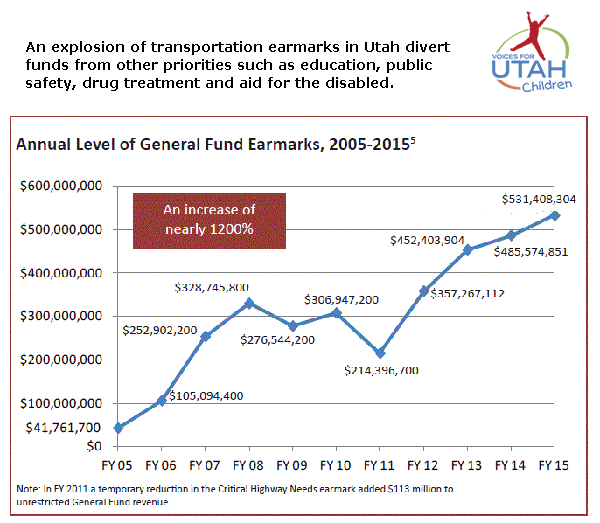
This explosion of earmarks has been primarily for the purpose of meeting the state’s transportation needs. The earmarks in question are all “unfunded” earmarks, meaning that none of them was created with a new revenue source to finance it, even though they address newly identified investments required to keep up with the state’s growing economy and population.
This enormous diversion of resources has meant that everything else financed by the General Fund, including education, public safety, drug treatment, aid for the disabled, support for vulnerable families, and many more, has been given short shrift, leaving critical needs unmet and allowing the state to fall behind in a number of important areas, threatening to undermine progress toward the state’s most important goals.
The rise of unfunded earmarks bears considerable resemblance to the decision made by an earlier generation of policy makers in 1996 to divert Education Fund revenues to fund higher education as well as K-12 education.
The report concludes with a call for a return to best practices in the annual budgeting process so as to allow policymakers to adapt to changing circumstances in good times and bad. Read the complete report:
What's Still Eating Utah's General Fund?
What Does the General Fund Do?
All Utahns benefit from an adequate General Fund. The state programs it pays for provide functional and efficient courts, a statewide system of colleges and universities, and the enforcement of rules regarding commercial transactions, environmental protection, water safety, control of contagious diseases, and much more. The GF also provides a safety net for families in need, including the disabled and those in need of drug treatment and mental health services.
Healthy Utah Poll Results
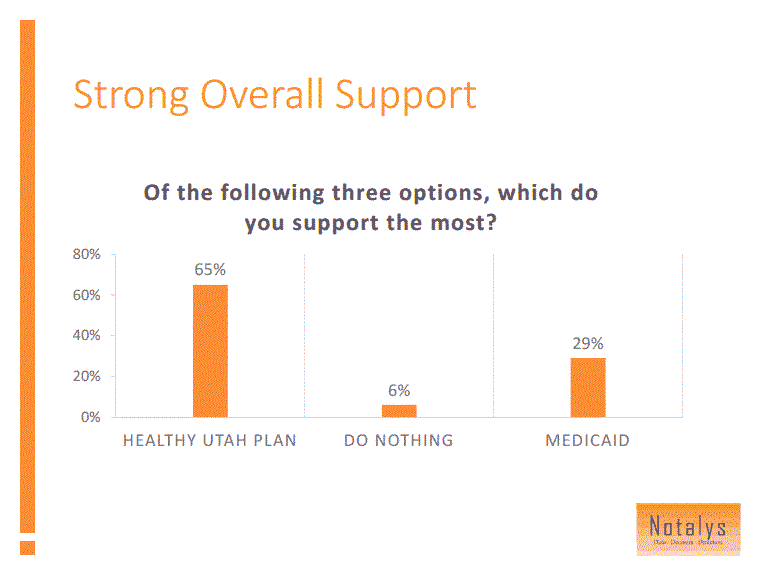 The Healthy Utah Poll was commissioned by a group of Utah civic groups interested in gauging support for Governor Herbert’s Healthy Utah plan. The poll was conducted by Dan Jones & Associates on a sample of 623 Utah voters during May and June, 2014. The full data and methods were then shared with Notalys for independent analysis. Notalys also consulted with the Dan Jones project leader on the development of the survey instrument. This report is the first set of research findings based on the poll. Complete poll results are found in this report along with a description of methods and an analysis of the results. The poll gives a clear and compelling summary of how Utah voters see the Healthy Utah plan, particularly in comparison to other options, such as a full Medicaid Expansion.
The Healthy Utah Poll was commissioned by a group of Utah civic groups interested in gauging support for Governor Herbert’s Healthy Utah plan. The poll was conducted by Dan Jones & Associates on a sample of 623 Utah voters during May and June, 2014. The full data and methods were then shared with Notalys for independent analysis. Notalys also consulted with the Dan Jones project leader on the development of the survey instrument. This report is the first set of research findings based on the poll. Complete poll results are found in this report along with a description of methods and an analysis of the results. The poll gives a clear and compelling summary of how Utah voters see the Healthy Utah plan, particularly in comparison to other options, such as a full Medicaid Expansion.
Download the complete report:
Key findings from the poll analysis
Widespread Support
- When compared with the option of doing nothing, 88% of Utah voters prefer the Healthy Utah plan, and 70% prefer Healthy Utah compared to a full Medicaid expansion.
- Healthy Utah has strong support across the state and among all demographic groups. Support is high for all age, education, race, gender, education and income categories.
No Partisan Divide
- Conservative Republicans support Healthy Utah. Among voters who identify as Republicans, 64% of those who are “very conservative” support the Governor’s plan, while just 13% oppose the plan.
- In general, support among Republicans is higher for Healthy Utah than it is among Democrats, since more Democrats favor Medicaid expansion.
Support for Affordable Health Care
- About 9% of likely voters are currently uninsured, even after healthcare.gov went into effect. A majority (54%) of voters know someone who is uninsured.
- Utahns think health insurance is very important, and, more surprisingly, 83% believe “all legal Utah residents should have access to affordable health insurance.”
- Utah voters believe that individual responsibility is important when it comes to insurance, but they are also supportive of government assistance for those who cannot afford coverage. Of the
- 65% of voters who agree that “individuals and families should generally be responsible for meeting their own healthcare needs,” 80% also agree with the statement that “individuals who are unable to afford health insurance should receive help from government sources.”
- Utahns are not opposed to a federal role in health care. 71% believe it is appropriate for the state to accept federal assistance in health care.
Support for Healthy Utah Plan Features
- A significant majority of voters are interested in the issue of health care, but only about 40% have heard of the new Healthy Utah plan thus far. When the details of the plan are provided, voters are in strong support.
- Utah voters strongly support the individual features of the Healthy Utah plan. Respondents say that the following features of the plan make them more likely to support it than they would otherwise:
- 59% are more likely to support the plan because it requires individuals to pay premiums and co‐pays (10% are less likely).
- 59% are more likely to support the plan because it provides private health insurance for people with low incomes rather than enrolling them in traditional Medicaid (14% are less likely).
- 68% are more likely to support the plan because it allows greater flexibility for how Utah spends federal dollars than allowed under traditional Medicaid (10% are less likely).
Opposed to Inaction
- The strongest consistency in the poll is that voters are very opposed to the status quo of doing nothing. Democrats are more inclined to do a Medicaid expansion, while Republicans support Governor Herbert’s plan. But both groups oppose the status quo. In a three‐way comparison, only 6% of the state voters prefer doing nothing.
- If Healthy Utah is rejected by federal officials, 65% would support a new Utah‐specific solution, and 28% support a Medicaid expansion. Only 7% would favor doing nothing.
- And, 54% of voters indicate they would be more likely to vote for legislators who support Healthy Utah. Only 14% indicate they would be less likely to vote for a legislator who supported the plan.
Poll Take‐Aways
- Utahns are overwhelmingly supportive of the features of Governor Herbert’s Healthy Utah plan.
- Utahns value individual responsibility, but both Republicans and Democrats are strongly supportive of a government role in assisting low‐income individuals to obtain health insurance.
- What Utahns are against, more than anything, is doing nothing.

